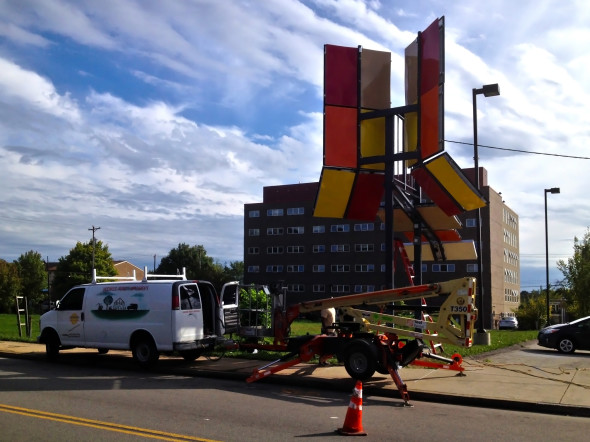TakePart/Participant Media | Oct. 23, 2015

The “Renaissance Gate” is a solar public art installation in Pittsburgh, Penn. designed by youth in the city’s Homewood neighborhood. (Photo credit: Land Art Generation Initiative)
Pennsylvania’s coal industry may be in decline, but in one of Pittsburgh’s toughest neighborhoods, a solar project could become a symbol of a brighter future.
“The idea of a ‘Renaissance Gate’ is a passageway through which visitors can walk from the old Homewood into a Homewood of the future—a place of prosperity and opportunity for those who call it home,” said Elizabeth Monoian, cofounder of the Pittsburgh-based Land Art Generation Initiative. The group sponsored an Art+Energy camp designed to teach young people about the social, political, environmental, and aesthetic aspects of energy production.
The 17 red, yellow, and orange solar panels are mounted atop the gate in a configuration mimicking the symmetry of a flower. The installation can produce enough electricity to power the lighting at the Homewood Renaissance Community Center through a hookup to its electrical meter. Two panels connected to a battery provide power for cell phone charging. The community center also receives a credit on its electricity bill by selling the energy that it doesn’t use to the local utility.
The 20 students enrolled in the camp learned about Western Pennsylvania’s deep roots in coal production and visited a local coal-fired power plant.
The Homewood Renaissance Association, which runs the community center, served as the link with the greater neighborhood community.
“All applauded the initiative to bringing solar energy to the neighborhood and loved that it was local kids leading the effort,” said Robert Ferry, LAGI’s other cofounder.
With only six weeks to complete the project, it was a race to the finish, according to Monoian, who said the team completed the detailed design drawings in the fourth week and sent them to a fabricator a week before the installation.
Ferry said he hopes the Renaissance Gate will be a catalyst for the area’s transformation.
“Energy democracy is a critical issue that must be addressed in neighborhoods such as Homewood,” he said. “Why aren’t there more solar installations in neighborhoods that could benefit greatly from them? We hope that the impact goes beyond Homewood and Pittsburgh to ignite a conversation about both our visual landscape in all neighborhoods and in the usefulness of distributed energy systems for empowering historically disadvantaged communities.”